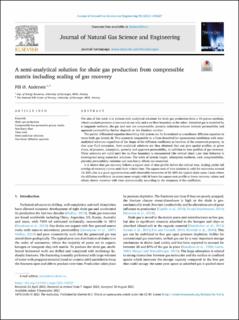| dc.contributor.author | Andersen, Pål Ø. | |
| dc.date.accessioned | 2021-10-18T17:26:25Z | |
| dc.date.available | 2021-10-18T17:26:25Z | |
| dc.date.created | 2021-09-22T17:39:34Z | |
| dc.date.issued | 2021-09 | |
| dc.identifier.citation | Andersen, P.Ø. (2021) A semi-analytical solution for shale gas production from compressible matrix including scaling of gas recovery. Journal of Natural Gas Science and Engineering, 95, 104227 | en_US |
| dc.identifier.issn | 1875-5100 | |
| dc.identifier.uri | https://hdl.handle.net/11250/2823747 | |
| dc.description.abstract | The aim of this work is to present semi-analytical solutions for shale gas production from a 1D porous medium, where constant pressure is assumed at one side and a no-flow boundary at the other. Adsorbed gas is modeled by a Langmuir isotherm, the gas and rock are compressible, porosity reduction reduces intrinsic permeability and apparent permeability further depends on the Knudsen number.
The partial differential equation describing this system can be formulated as a nonlinear diffusion equation in terms bulk gas density M. This system is comparable to a form described for spontaneous imbibition with semi-analytical solutions regardless of the shape of the diffusion coefficient as function of the conserved property, in that case fluid saturation. Semi-analytical solutions are thus obtained that can give spatial profiles, at given times, of pressure, adsorption, porosity and apparent permeability, in addition to time profiles of gas recovery. These solutions are valid until the no-flow boundary is encountered (the critical time). Late time behavior is investigated using numerical solutions. The roles of system length, adsorption isotherm, rock compressibility, porosity-permeability relations and non-Darcy effects are examined.
It is shown that gas recovery follows a square root of time profile before the critical time. Scaling yields full overlap of recovery curves until their critical time. The square root of time solution is valid for recoveries around 12–22%, but is a good approximation until obtainable recoveries of 35–50% for typical shale cases. Cases where the diffusion coefficient increases more steeply with M leave the square root profile at lower recovery values and obtain slower recovery with time systematically according to the steepness of the coefficient. | en_US |
| dc.language.iso | eng | en_US |
| dc.publisher | Elsevier Ltd. | en_US |
| dc.rights | Navngivelse 4.0 Internasjonal | * |
| dc.rights.uri | http://creativecommons.org/licenses/by/4.0/deed.no | * |
| dc.subject | petroleumsteknologi | en_US |
| dc.subject | naturgass | en_US |
| dc.subject | shale gas | en_US |
| dc.title | A semi-analytical solution for shale gas production from compressible matrix including scaling of gas recovery | en_US |
| dc.type | Peer reviewed | en_US |
| dc.type | Journal article | en_US |
| dc.description.version | publishedVersion | en_US |
| dc.rights.holder | © 2021 The Author(s). | en_US |
| dc.subject.nsi | VDP::Teknologi: 500::Berg‑ og petroleumsfag: 510 | en_US |
| dc.source.volume | 95 | en_US |
| dc.source.journal | Journal of Natural Gas Science and Engineering | en_US |
| dc.identifier.doi | 10.1016/j.jngse.2021.104227 | |
| dc.identifier.cristin | 1937330 | |
| dc.source.articlenumber | 104227 | en_US |
| cristin.ispublished | true | |
| cristin.fulltext | original | |
| cristin.qualitycode | 1 | |

